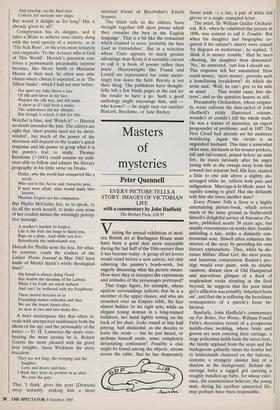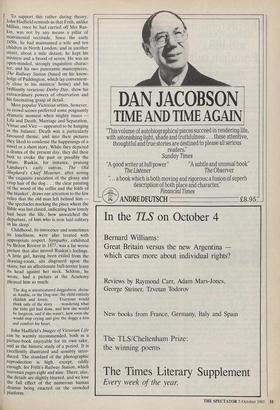Masters of mysteries
Peter Quennell
EVERY PICTURE TELLS A STORY: IMAGES OF VICTORIAN LIFE with a commentary by John Hadfield
The Herbert Press, f10.95
Visiting the annual exhibition of mod- ern British art at Burlington House must have been a good deal more enjoyable during the last half of the 19th century than it has become today. A group of art-lovers would stand before a new canvas, not only admiring the painter's brush-work, but eagerly discussing what his picture meant. How were they to interpret the expressions and attitudes of the personages portrayed?
That tragic figure, for example, whose opulent surroundings indicate that he is a member of the upper classes, and who sits crouched over an Empire table, his face almost hidden by his right arm, while an elegant young woman in a long-trained balldress, her hand lightly resting on the back of his chair, looks round at him half pitying, half disdainful, as she decides to leave the room — has he just heard, or perhaps himself made, some completely devastating confession? Possibly a clue might be found among the objects, strewn across the table, that he has desperately thrust aside — a fan, a pair of white kid gloves or a single crumpled letter.
The artist, Sir William Quiller Orchard- son, RA, when he exhibited this picture in 1896, was content to call it Trouble. But when his daughter and biographer en- quired if his subject's misery were caused `by disgrace or misfortune', he replied, 'I think it is money trouble.' Had he been cheating, his daughter then demanded. `No,' he answered, 'just loss I should say.' This response left her unsatisfied. How could money, 'mere money', provoke such a humiliating breakdown? At which the artist said, 'Well, he can't give to his wife as usual . . . That would cause him dis- tress'; and so the question haunts us still.
Presumably Orchardson, whose enigma- tic scene enlivens the dust-jacket of John Hadfield's richly illustrated volume, wouldn't or couldn't tell the whole truth. He was a master of mysteries, an expert propounder of problems; and in 1887 The First Cloud had already set his audience wondering. Again the victim is an anguished husband. This time a somewhat older man, his hands in his trouser pockets, tall and tail-coated, poised before an unlit fire, he stares furiously after his angry young wife as she sweeps away from him towards her separate bed. His face, slanted a little to one side above a slightly dis- arranged white tie, reflects both pain and indignation. Marriage-l-la-Mode must be rapidly coming to grief. Has she defiantly told him she loves another man?
Every Picture Tells a Story is a highly entertaining picture-book, which covers much of the same ground as Sacheverell Sitwell's delightful survey of Narrative Pic- tures, published nearly 50 years ago, but usually concentrates on works that, besides unfolding a tale, strike a distinctly con- troversial note. Sitwell often enhances the interest of the story by providing his own literary explanations. Thus, while he dis- cusses Millais' Blind Girl, the most poetic and luminous composition Ruskin's pro- tdge would ever paint, with its double rainbow, distant view of Old Hampstead and marvellous glimpse of a flock of resplendent rooks strutting in the field beyond, he suggests that the poor blind girl's affliction was possibly 'inherited from sin', and that she is suffering the hereditary consequences of a parent's loose be- haviour.
Similarly, John Hadfield's commentary on For Better, For Worse, William Powell Frith's decorative record of a prosperous middle-class wedding, where bride and groom are seen entering their carriage, a large policeman holds back the street boys, the family applaud from the steps and the bridegroom gallantly raises his bowler hat to bridesmaids clustered on the balcony, contains a strangely sinister hint of a shadow in the background. Behind the carriage lurks a ragged girl carrying a roughly bundled up baby, for whose exist- ence, the commentator believes, the young man, during his carefree unmarried life, may perhaps have been responsible. To support this rather daring theory, John Hadfield reminds us that Frith, unlike Millais, once he had carried off Mrs Rus- kin, was not by any means a pillar of matrimonial rectitude. Since the early 1850s, he had maintained a wife and ten children in 'North London, and in another street, about a mile distant, he kept his mistress and a brood of seven. He was an open-minded, strongly inquisitive charac- ter; and his two panoramic masterpieces, The Railway Station (based on his know- ledge of Paddington, which lay convenient- ly close to his mistress' home) and his brilliantly vivacious Derby Day, show his extraordinary powers of observation and his fascinating grasp of detail.
Most popular Victorian artists, however, to crowd scenes preferred some poignantly dramatic moment when mighty issues Life and Death, Marriage and Separation, Virtue and Vice — appeared to be hanging In the balance. Death was a particularly favoured theme; and into their pictures they liked to condense the happenings of a novel or a short story. While they depicted a drama of the present day, they did their best to evoke the past or possibly the future. Ruskin, for instance, praising Landseer's early canvas, The Old Shepherd's Chief Mourner, after noting 'the exquisite execution of the glossy and crisp hair of the dog . . the clear painting of the wood of the coffin and the folds of the blanket', draws our attention to the few relics that the old man left behind him 'the spectacles marking the place where the Bible was last closed, indicating how lonely had been the life, how unwatched the departure, of him who is now laid solitary In his sleep'.
Childhood, its innocence and sometimes Its loneliness, were also treated with appropriate respect. Sympathy, exhibited by Briton Riviere in 1877, was a far worse picture that also moved Ruskin's feelings. A little girl, having been exiled from the drawing-room, sits disgraced upon the stairs; but an affectionate bull-terrier leans its head against her neck. Seldom, he wrote, had a picture at the Academy pleased him so much:
The dog is uncaricatured doggedness, divine as Anubis, or the Dog-star; the child entirely childish and lovely . . . Everyone would think only of the story . . wondering what the little girl had done, and how she would be forgiven, and if she wasn't, how soon she would stop crying and give the doggy a kiss and comfort his heart.
John Hadfield's Images of Victorian Life can be warmly recommended, both as a picture-book enjoyable for its own sake, and as the historic study of a period. It is excellently illustrated and sensibly intro- duced. The standard of the photographic reproduction is high, except, oddly enough, for Frith's Railway Station, which traverses pages eight and nine. There, alas, the details are slightly blurred, and we lose the full effect of the numerous human dramas being enacted on the crowded platform.



























































 Previous page
Previous page